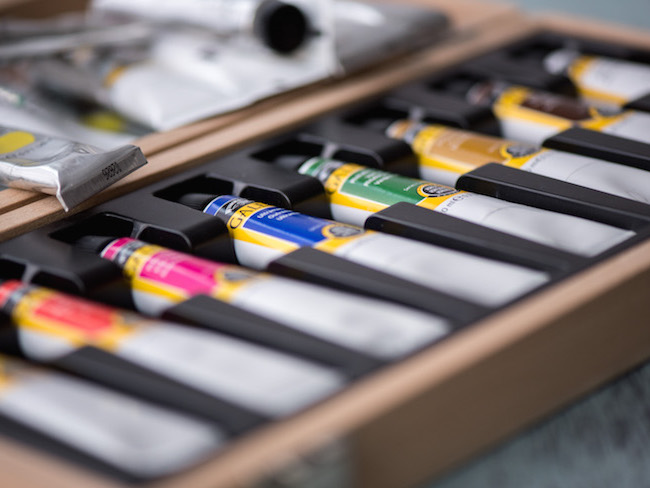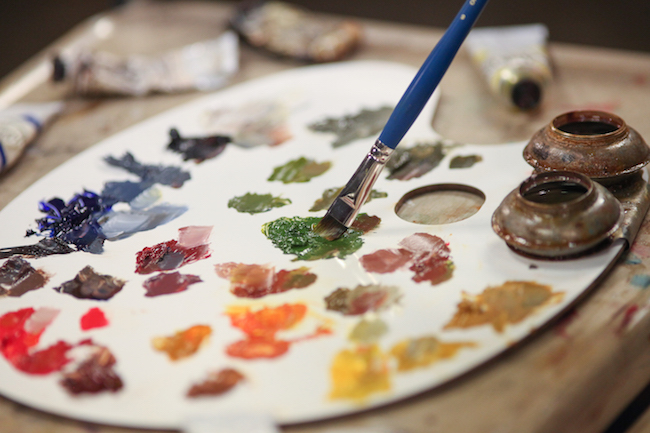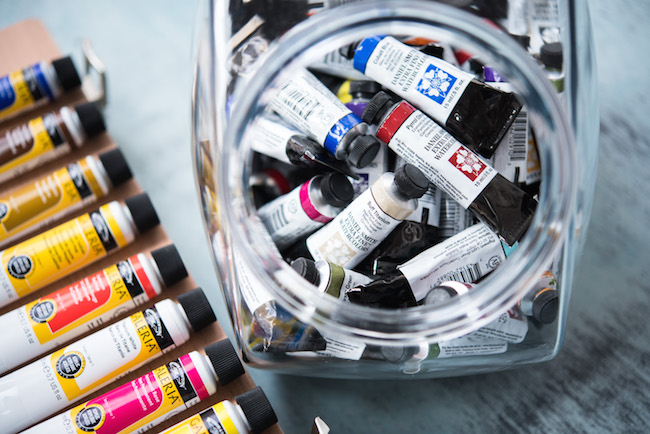If you’re interested in taking up painting, one of the first decisions you’ll have to make is what type of paint you’d like to try first. For fine art painting, two of the key types of paint are acrylic and oil paint. But when it comes to oil vs. acrylic, which one is the best choice for your painting?

To the naked eye, these two types of paint may seem identical, but this is not the case. While both are used to create beautiful works of art, they have some important differences that you should consider as a painter. This guide is meant to demystify these two types of paint in order to help you decide which might be best suited for you and your unique style of painting.
Let’s start with a brief description of what each type of paint is.
Acrylic paint

This is a fast-drying type of paint, wherein the paint’s pigment is suspended in an acrylic polymer emulsion.
While the paint is still wet, it is liquid soluble; the paint can be diluted and brushes cleaned with water. Once the paint dries, however, it is water-resistant, with a plastic texture.
Acrylic paint can be manipulated with any number of “medium” mix-ins, gels or texture pastes to attain different finishes, from a high-gloss to a dull matte to sandy textures.
Oil paint

This slow-drying variety of paint features paint pigment suspended in a solid oil, often linseed oil. The oil makes it non-water soluble, so to mix and dilute oil paint, you’ll need some sort of spirit solvent. The paint dries slowly and will ultimately “set,” but applying a solvent will break down the paint.
Key differences between oil and acrylic paint
Note: These differences primarily reflect traditional acrylic and oil paint rather than alternative versions of each (such as water-soluble oil paint or sticks).
Solubility
Acrylic paint is water soluble, whereas traditional oil paint requires a paint-thinning solution, such as linseed oil, to mix. (Note: water-soluble oil paints do exist, which would not require linseed oil to mix).
Cleaning brushes
Acrylic paint brushes can be cleaned with water. Brushes used for oil paint, however, will repel water, making this an ineffective mode of cleaning. Instead, a paint-thinning solution such as turpentine is used to clean brushes.
Speed of drying
Acrylic paint dries quickly; most portions of a painting will dry in minutes, and even the thickest portions of or applied acrylic will dry in an hour or so. On the other hand, oil paint dries very slowly. Depending on the thickness of the paint, it can take days for a portion of the painting to dry completely.Quality of dried paint
Once acrylic paint dries, it is permanent and cannot be altered; oil paint can be re-moistened with a medium and added to or altered.
Color of dried paint
Acrylic paint will typically dry slightly darker than when it looks when wet, which requires a bit of forethought in your painting. This means that you’ll have to mix a color that is slightly lighter than you’d like, as the paint will dry slightly darker. Oil paint, on the other hand, will dry pretty much the same color as applied.
Prepping your work surface
While acrylic can be painted directly on a work surface, oil paint absolutely requires a prepped work surface. Oil paints can corrode a work surface over time, so you always have to prime a canvas, board, or even paper before painting. Learn how to prime a canvas here.

What paint should you use?
While ultimately your painting medium of choice should be your own decision and reflect your artistic style and preference, here are some thoughts on which type of paint might be more appropriate in a variety of common situations.
When to use acrylic paint
When you’re first getting started with fine art painting.
Acrylic is definitely an easier medium to get started with; all you need is paint, water, a paintbrush and a work surface. It requires minimal investment and can allow you to just get painting far more quickly.
When you don’t have a lot of time or space to paint.
Your setup with acrylic paint can be fairly minimal: palette, brush, water and work surface. Since the paint dries fairly quickly, you don’t have to leave your painting out to dry for a long time. An oil painting, on the other hand, will require a more involved setup, ventilation (for the turpentine or mineral spirits you’ll be using) and a safe space for the painting to slowly dry.
When you want to create a mixed media painting.
Since acrylic is non-corrosive and water soluble, it is far easier to incorporate into a mixed media painting or piece of art, as it won’t damage or degrade other elements of the piece.
If you’re painting a craft item.
If you’re taking your paint off the canvas and painting a craft item or atypical surface, be it a yoga mat or a pair of shoes, acrylic is a better choice. Its plasticity and low drying time makes it a clean, easy and effective way to paint off-canvas.
When to use oil paint
When you want to paint in layers.
Because oil paint can be manipulated more than quick-drying acrylic paint, it is better for painting in layers and layers of color in the style of old masters. When built up in many layers, this can yield beautiful, vibrant paintings. It can be harder to attain a rich layered technique with acrylic, since it will dry solid and any layer painted on top of the previous will reflect the texture of the brush marks below.
When you want the colors you paint to look the same when they dry.
The fact that acrylic paint dries slightly darker than when applied can be difficult to wrap your mind around. If you think that this will cause a sense of dissonance in your artistic process, you may want to stick with oil paint, which will dry pretty much the same color as when applied.
When painting an involved scene which will take more than one session to paint.
If you’re creating a large or involved piece of art that will require many sessions to complete, oil paint may be a better choice than acrylic. Since it dries slower and can be re-moistened later with a solvent, it is better suited to long-term or highly involved painting projects.

Very Informative - helped me understand the difference between the two.